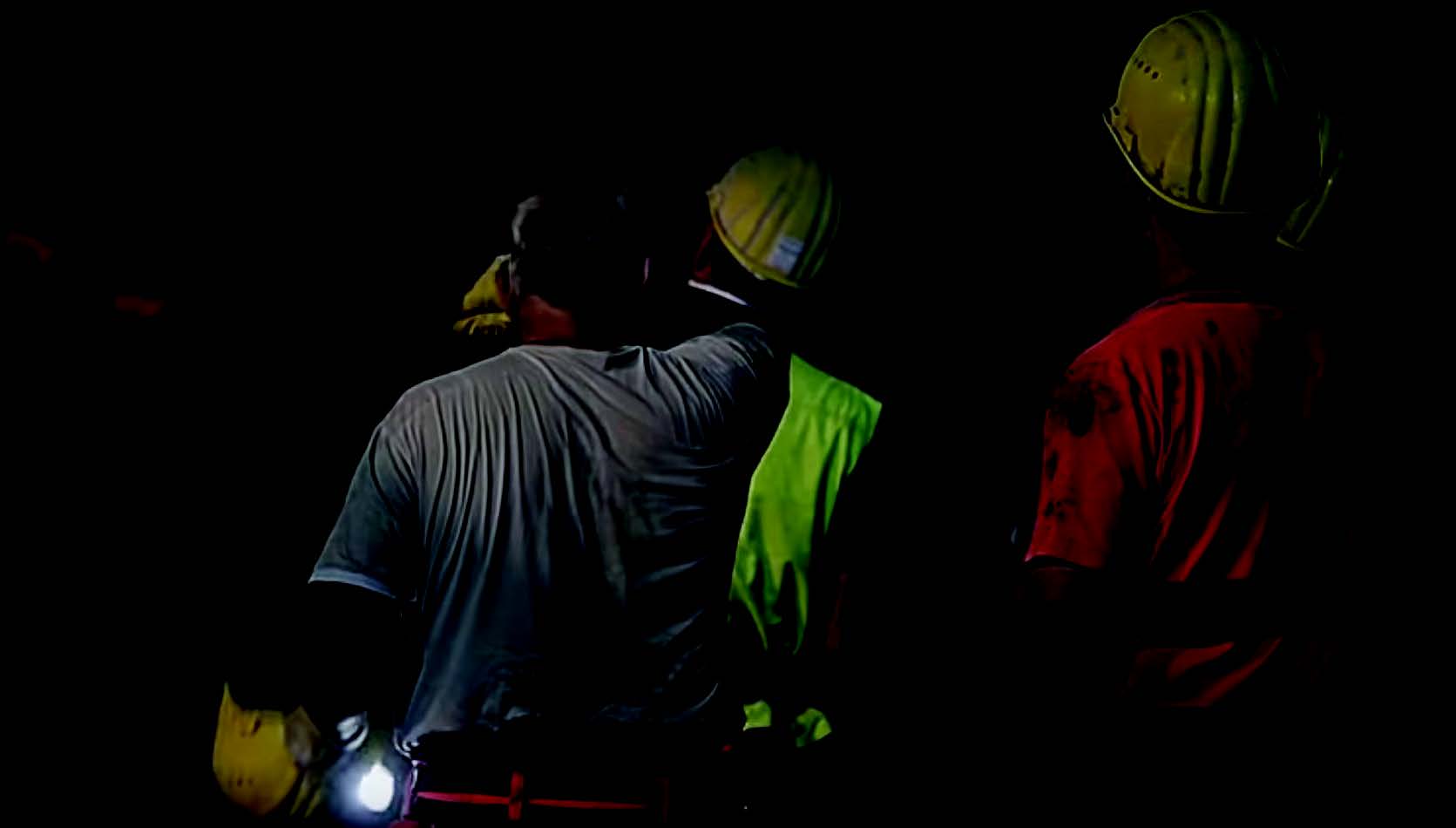Leapfrog Works represents a fast, powerful and user friendly software, with good graphics, fast calculations and interdisciplinary ability for including different structures.
Tina Zivec, Geologist, Elea
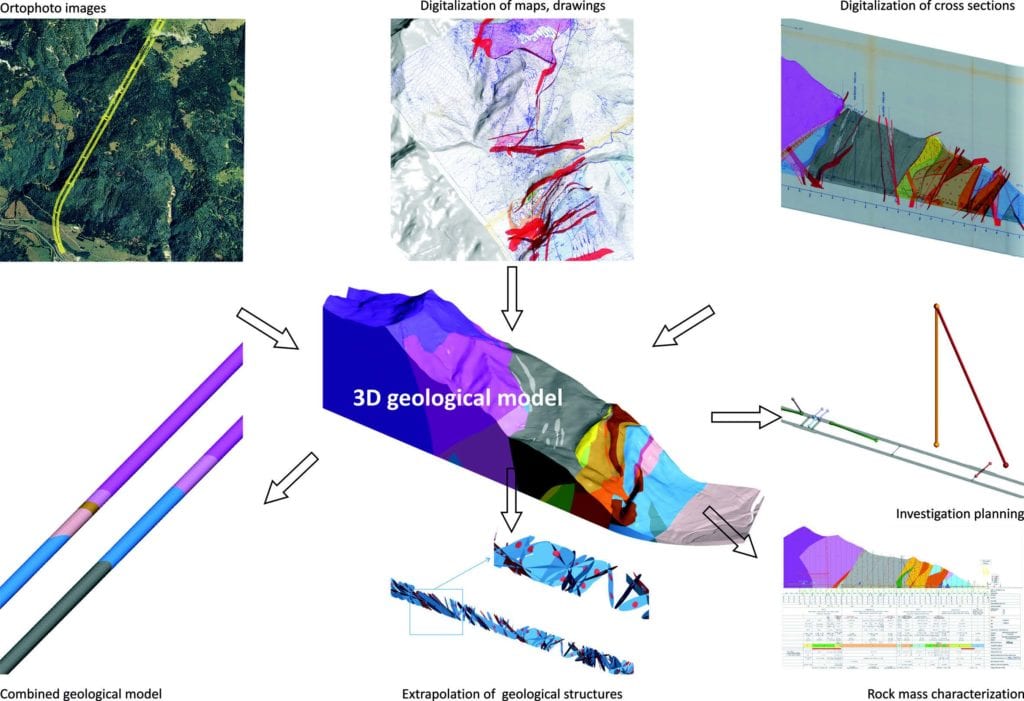
Following the design approval, a full preliminary tunnel BIM model was produced. Due to different technology behind BIM and the Leapfrog model, models could not be integrated in a common environment without losing some information. Nevertheless, transformed tunnel geometry in Leapfrog Works allowed the extraction of several different combined models to precisely predict excavation volumes, distribution and quantities of each ground type and the identification of critical intersecting structural discontinuities. Visualisation helped in defining the investigation program and much more. Information and graphics extracted from the Leapfrog Works model were used to define the support distribution along the tunnel. This was used as a basis to generate discretized mesh for Finite-Element calculations.
Outcome
Using Leapfrog Works for the tunnelling project allowed the ready visualisation of ground conditions based on unambiguous input data. This data could be used for further calculations, stability and deformation potential analysis. Benefits of using the software included:
- Fast and easy combining of different data types – Leapfrog Works allowed the modellers to use complex and varied types of data collected from both desk study and in situ investigation.
- Rapid visualisation and understanding – Evaluating feasibility, identifying clashes between different models, checking specifications, scheduling and costings simultaneously in different views gives far more control over design than checking PDF drawings, time schedule sheets, specifications and bills of quantities. These advantages will be enhanced during construction when changes can be evaluated in almost real time and easily recorded along with approval information.
- Access to state of the art geological modelling – Leapfrog Works is an advanced, specialised geological modelling tool specifically designed to model faults, intrusions and deposits.
- Facilitating a process of refinement – Modellers are able to readily incorporate new information. The complexity of the geological structure was monitored during the excavation of the existing tunnel tube, as the geological conditions changed in short distances. Daily geological face logging, geotechnical and surveying monitoring was incorporated into the model. This process can continue during construction of the second tunnel tube.
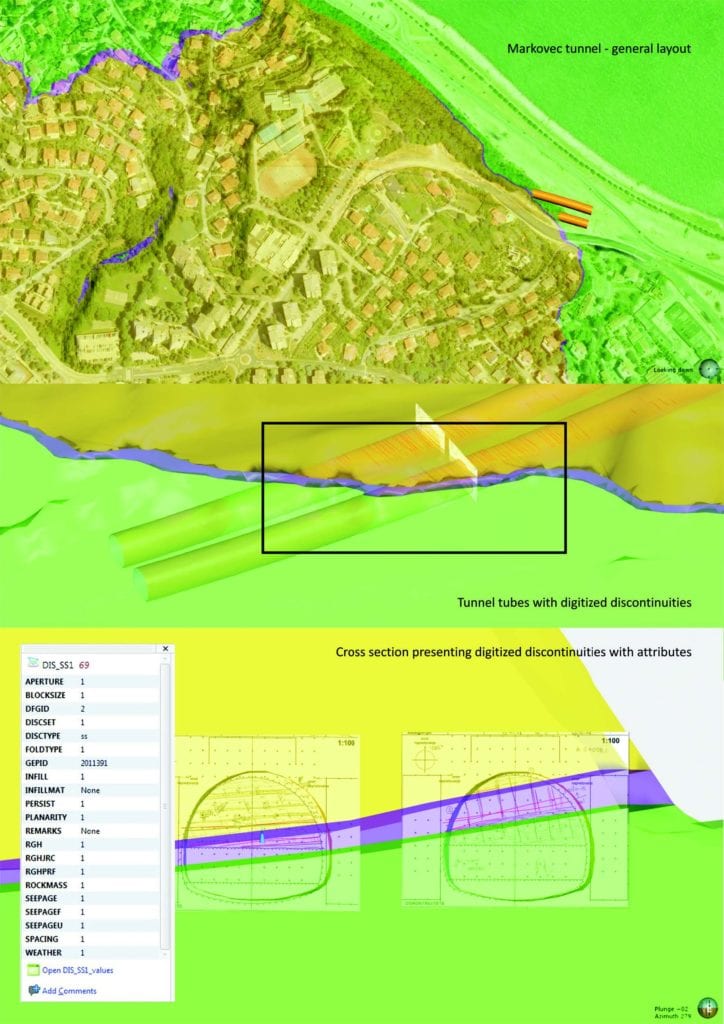
Duration
2 min
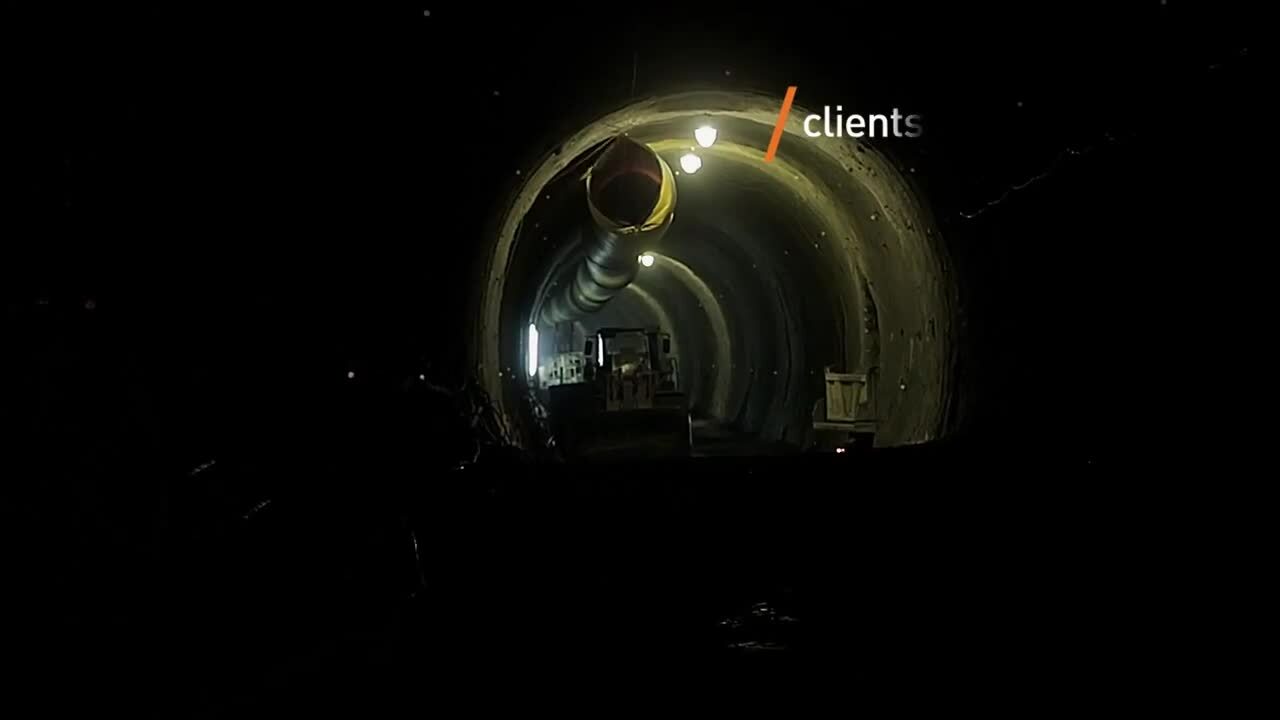
See more on demand videos
VideosFind out more about Seequent's civil solutions
Learn moreVideo Transcript
The video transcript gets copy and pasted here
The Karasvanke tunnel project, ELEA IC (Solvenia)
The Project
The Karavanke tunnel, constructed in the 1980s, cuts through the Alps between Slovenia and Austria and represents a critical point on Pan-European Transport Corridor X. The need for improved traffic flow and enhanced road safety led, in 2013, to the planning of a second tunnel tube.
The design of the second tunnel tube represents a 7820 m long two-lane tunnel tube with up to 1000 m overburden. The geology is very complex due to its imbricate fan structure, which has formed as an array of overlapping fault-propagation folds. The initial tunnel encountered difficult geological conditions with frequent strong water inflow, overbreaks and methane detection. A series of geological, geotechnical and hydrogeological investigations carried out since the 1970s, resulted in extensive project documentation.
The interdisciplinary consulting company Elea iC, the leading partner of the Joint Venture Karavanke, used Leapfrog Works to model the geology as part of the Idea Phase project for the Slovenian part of the second tunnel tube.
Situation
Traditionally, 3D geological modelling in the civil industry has been limited to the 2D interpretation in a 3D environment. This process is time consuming, with loss of information between sections and subjective interpretations of the geological conditions and potential risk assessment. Manual 2D interpretations are also difficult to update increasing risk. The Karavanke tunnel project and extensive dataset presented Elea iC with the opportunity to test emerging technologies and move engineering geology, geotechnics and tunnelling to another level.
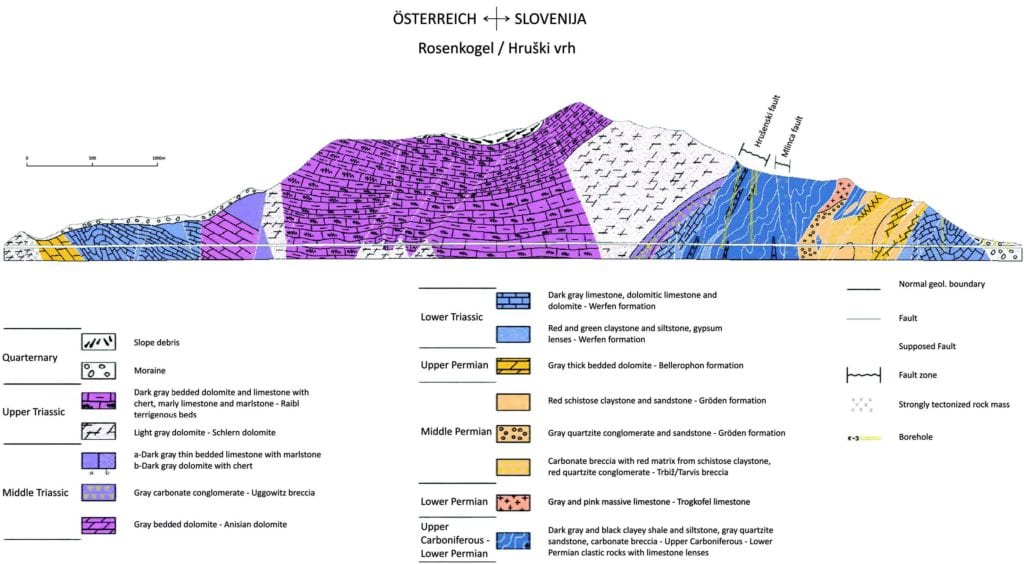
Response
Defining the geological structure along the tunnel tube
The 3D model was built based on the extensive geological data from previous investigation and construction phases, upgraded with new findings. The single model used all available loggings, map faces, and measurements.
Says Tina Zivec, “The extensive interdisciplinary experience of Seequent’s development and support team enabled them to quickly understand the problem we faced with building the model in the most challenging disciplines.”
Due to a lack of borehole data the model was built by determining the fault system. Major faults were determined as GIS polylines and aligned to the topography. Modelled faults and structural data from outcrops were then corrected to geological cross-sections along the tunnel alignment.
Structural data from detailed geological profiles, based on geological face logging during the excavation phase, were used for orienting fault planes in the tunnel level.
The generated fault system cut the 3D model into numerous fault blocks. Appropriate lithostratigraphic units were assigned to each block. From the resulting 3D model, lithological and structural properties were extracted to create detailed geological profiles, as well as a structural model for extrapolating structural properties to the planned tunnel tube as a DFN (Discrete Fracture Network).
The 3D model allowed users to predict the location and orientation of major fault systems, general ground conditions and rock mass behaviour and aided designing support types for constructing the new tunnel tube.
Information Management
In addition to aiding significantly in the design of the new tunnel tube, Leapfrog Works also enabled synergy with BIM processes. A Leapfrog Works model is essentially an information model built under different standards.
Leapfrog Works represents a fast, powerful and user friendly software, with good graphics, fast calculations and interdisciplinary ability for including different structures.
Tina Zivec, Geologist, Elea

Following the design approval, a full preliminary tunnel BIM model was produced. Due to different technology behind BIM and the Leapfrog model, models could not be integrated in a common environment without losing some information. Nevertheless, transformed tunnel geometry in Leapfrog Works allowed the extraction of several different combined models to precisely predict excavation volumes, distribution and quantities of each ground type and the identification of critical intersecting structural discontinuities. Visualisation helped in defining the investigation program and much more. Information and graphics extracted from the Leapfrog Works model were used to define the support distribution along the tunnel. This was used as a basis to generate discretized mesh for Finite-Element calculations.
Outcome
Using Leapfrog Works for the tunnelling project allowed the ready visualisation of ground conditions based on unambiguous input data. This data could be used for further calculations, stability and deformation potential analysis. Benefits of using the software included:
- Fast and easy combining of different data types – Leapfrog Works allowed the modellers to use complex and varied types of data collected from both desk study and in situ investigation.
- Rapid visualisation and understanding – Evaluating feasibility, identifying clashes between different models, checking specifications, scheduling and costings simultaneously in different views gives far more control over design than checking PDF drawings, time schedule sheets, specifications and bills of quantities. These advantages will be enhanced during construction when changes can be evaluated in almost real time and easily recorded along with approval information.
- Access to state of the art geological modelling – Leapfrog Works is an advanced, specialised geological modelling tool specifically designed to model faults, intrusions and deposits.
- Facilitating a process of refinement – Modellers are able to readily incorporate new information. The complexity of the geological structure was monitored during the excavation of the existing tunnel tube, as the geological conditions changed in short distances. Daily geological face logging, geotechnical and surveying monitoring was incorporated into the model. This process can continue during construction of the second tunnel tube.

Duration
2 min

See more on demand videos
VideosFind out more about Seequent's civil solutions
Learn moreVideo Transcript
The video transcript gets copy and pasted here
The Karasvanke tunnel project, ELEA IC (Solvenia)
The Project
The Karavanke tunnel, constructed in the 1980s, cuts through the Alps between Slovenia and Austria and represents a critical point on Pan-European Transport Corridor X. The need for improved traffic flow and enhanced road safety led, in 2013, to the planning of a second tunnel tube.
The design of the second tunnel tube represents a 7820 m long two-lane tunnel tube with up to 1000 m overburden. The geology is very complex due to its imbricate fan structure, which has formed as an array of overlapping fault-propagation folds. The initial tunnel encountered difficult geological conditions with frequent strong water inflow, overbreaks and methane detection. A series of geological, geotechnical and hydrogeological investigations carried out since the 1970s, resulted in extensive project documentation.
The interdisciplinary consulting company Elea iC, the leading partner of the Joint Venture Karavanke, used Leapfrog Works to model the geology as part of the Idea Phase project for the Slovenian part of the second tunnel tube.
Situation
Traditionally, 3D geological modelling in the civil industry has been limited to the 2D interpretation in a 3D environment. This process is time consuming, with loss of information between sections and subjective interpretations of the geological conditions and potential risk assessment. Manual 2D interpretations are also difficult to update increasing risk. The Karavanke tunnel project and extensive dataset presented Elea iC with the opportunity to test emerging technologies and move engineering geology, geotechnics and tunnelling to another level.

Response
Defining the geological structure along the tunnel tube
The 3D model was built based on the extensive geological data from previous investigation and construction phases, upgraded with new findings. The single model used all available loggings, map faces, and measurements.
Says Tina Zivec, “The extensive interdisciplinary experience of Seequent’s development and support team enabled them to quickly understand the problem we faced with building the model in the most challenging disciplines.”
Due to a lack of borehole data the model was built by determining the fault system. Major faults were determined as GIS polylines and aligned to the topography. Modelled faults and structural data from outcrops were then corrected to geological cross-sections along the tunnel alignment.
Structural data from detailed geological profiles, based on geological face logging during the excavation phase, were used for orienting fault planes in the tunnel level.
The generated fault system cut the 3D model into numerous fault blocks. Appropriate lithostratigraphic units were assigned to each block. From the resulting 3D model, lithological and structural properties were extracted to create detailed geological profiles, as well as a structural model for extrapolating structural properties to the planned tunnel tube as a DFN (Discrete Fracture Network).
The 3D model allowed users to predict the location and orientation of major fault systems, general ground conditions and rock mass behaviour and aided designing support types for constructing the new tunnel tube.
Information Management
In addition to aiding significantly in the design of the new tunnel tube, Leapfrog Works also enabled synergy with BIM processes. A Leapfrog Works model is essentially an information model built under different standards.
Leapfrog Works represents a fast, powerful and user friendly software, with good graphics, fast calculations and interdisciplinary ability for including different structures.
Tina Zivec, Geologist, Elea

Following the design approval, a full preliminary tunnel BIM model was produced. Due to different technology behind BIM and the Leapfrog model, models could not be integrated in a common environment without losing some information. Nevertheless, transformed tunnel geometry in Leapfrog Works allowed the extraction of several different combined models to precisely predict excavation volumes, distribution and quantities of each ground type and the identification of critical intersecting structural discontinuities. Visualisation helped in defining the investigation program and much more. Information and graphics extracted from the Leapfrog Works model were used to define the support distribution along the tunnel. This was used as a basis to generate discretized mesh for Finite-Element calculations.
Outcome
Using Leapfrog Works for the tunnelling project allowed the ready visualisation of ground conditions based on unambiguous input data. This data could be used for further calculations, stability and deformation potential analysis. Benefits of using the software included:
- Fast and easy combining of different data types – Leapfrog Works allowed the modellers to use complex and varied types of data collected from both desk study and in situ investigation.
- Rapid visualisation and understanding – Evaluating feasibility, identifying clashes between different models, checking specifications, scheduling and costings simultaneously in different views gives far more control over design than checking PDF drawings, time schedule sheets, specifications and bills of quantities. These advantages will be enhanced during construction when changes can be evaluated in almost real time and easily recorded along with approval information.
- Access to state of the art geological modelling – Leapfrog Works is an advanced, specialised geological modelling tool specifically designed to model faults, intrusions and deposits.
- Facilitating a process of refinement – Modellers are able to readily incorporate new information. The complexity of the geological structure was monitored during the excavation of the existing tunnel tube, as the geological conditions changed in short distances. Daily geological face logging, geotechnical and surveying monitoring was incorporated into the model. This process can continue during construction of the second tunnel tube.

Duration
2 min

See more on demand videos
VideosFind out more about Seequent's civil solutions
Learn moreVideo Transcript
The video transcript gets copy and pasted here





